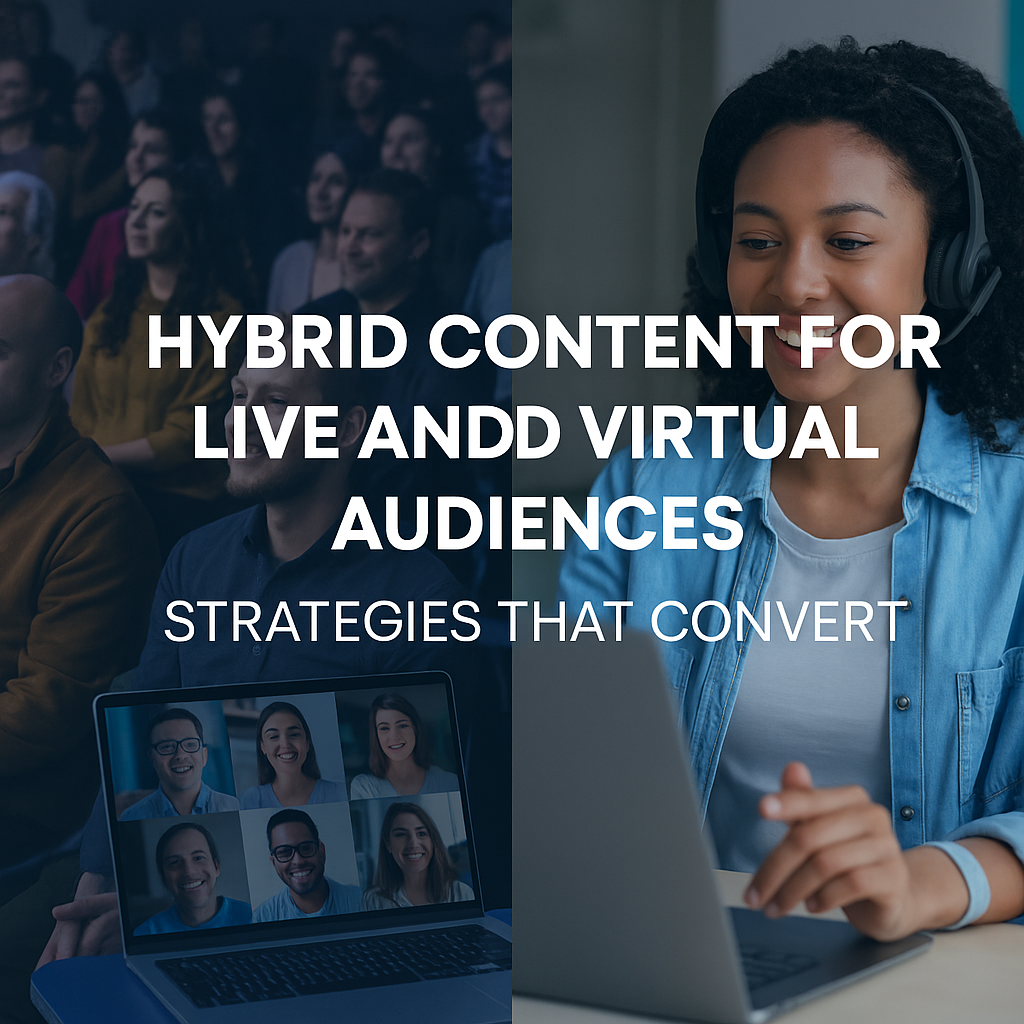When your audience can be anywhere, your event can go everywhere. Hybrid content isn’t just a fallback plan — it’s a growth engine. Markletic research shows that 86% of B2B organizations see a positive ROI from hybrid events within seven months, proving that blending in-person and virtual experiences isn’t just viable, it’s a competitive advantage.

Hybrid content strategy is the intentional design of event experiences to serve both live and virtual audiences simultaneously, using technology, storytelling, and engagement tactics tailored to each group. Audience preferences have fractured; some thrive on the energy of in-person gatherings, while others demand the flexibility and accessibility of virtual participation. Businesses that design for both expand their reach, diversify revenue streams, and future-proof their event portfolios against market or regulatory shifts.
B2B vs. B2C Impact
In B2B, hybrid events provide a scalable way to deepen relationships across regions without sacrificing the high-value networking and education that drives deal acceleration. Decision-makers expect tailored, data-rich experiences, and hybrid formats allow for personalized agendas and digital content libraries that extend beyond the event itself.
For B2C, the opportunity lies in creating brand moments that are inclusive and shareable. Hybrid product launches, fan conventions, and lifestyle events give consumers the choice to participate in ways that fit their lifestyle — boosting brand affinity and social media amplification.
Factics (Data + Direct Application)
• Stat: 71.1% of organizers say connecting in-person and virtual audiences is their biggest challenge (Markletic).
Tactic: Integrate live polls and Q&A tools where responses from both audiences appear on the same feed, creating shared interaction points.
• Stat: 81% of organizers identify networking capabilities as the top contributor to hybrid event satisfaction (Markletic).
Tactic: Use platform features like breakout rooms or “speed networking” to simulate informal, in-person conversations for virtual attendees.
• Stat: Live sessions increase audience engagement by 66% (Markletic).
Tactic: Avoid over-reliance on pre-recorded content; where recording is necessary, include a live facilitator to engage in real-time chat and commentary.
• Stat: PCMA research shows most planners see hybrid events as a long-term fixture in their portfolio.
Tactic: Build hybrid workflows into your annual event planning cycle to normalize costs, staffing, and technology investment.
Platform Playbook
Goal: Maximize simultaneous engagement for both live and virtual audiences while extending post-event value.
• HubSpot – Use event microsites to host live streams, chat rooms, and post-event on-demand content, increasing the shelf-life of key sessions.
• Adobe – Incorporate hybrid-friendly design into session planning; shorter, high-impact content segments cater to digital attention spans while keeping in-person energy high.
• Cvent – Leverage dual-capacity management to control in-person attendance while leaving virtual capacity open, ensuring no audience is turned away.
• American Meetings – Assign dedicated virtual facilitators to champion online audience needs in real time.
• Markletic – Benchmark engagement and ROI metrics after each hybrid event to refine the mix of live vs. virtual formats in future strategies.
Best Practice Spotlight
Before the hybrid model became mainstream, TED began experimenting with integrating live, in-room storytelling and a robust online community experience. Each TED conference was filmed and live-streamed to partner viewing locations globally, where audiences gathered to watch, network, and discuss in real time. This “distributed event” model created intimacy in local gatherings while connecting participants to the global stage — a principle that remains at the heart of hybrid event design today (TED, 2019).
Hypotheticals Imagined
Scenario 1: B2B Tech Conference Expansion
A leading software company traditionally hosts a 1,000-person annual conference in one city. By introducing a hybrid format, they keep the flagship in-person experience but stream 80% of sessions through a dedicated microsite with interactive chat. Virtual attendees can schedule one-on-one meetings with sales reps using the platform’s networking tool.
Execution:
– In-person: targeted executive roundtables, product demos, evening networking receptions.
– Virtual: real-time session polls, moderated Q&A, instant replay library.
Expected Outcomes: 30% increase in total attendance, expanded reach into untapped regions, and a 20% faster sales cycle from leads generated online.
Pitfalls to Avoid: Neglecting time zone considerations for global virtual attendees, leading to drop-offs in engagement.
Scenario 2: B2C Lifestyle Brand Launch
A consumer fitness brand is unveiling a new product line. Instead of a single in-store event, they run simultaneous local pop-up experiences and a global live stream featuring workout sessions, influencer interviews, and exclusive online discounts.
Execution:
– In-person: experiential zones with product trials, social media photo booths.
– Virtual: shoppable video player, live giveaways for online participants, gamified challenges synced to wearable devices.
Expected Outcomes: Doubling of online sales during the launch week, 40% increase in social mentions, and strong earned media coverage.
Pitfalls to Avoid: Treating the online experience as a passive stream without interactive elements — reducing virtual conversion rates.
Scenario 3: Nonprofit Fundraising Gala
A nonprofit with a loyal local donor base wants to grow national support. They host an elegant in-person gala while streaming a parallel program to virtual attendees, including behind-the-scenes segments and exclusive performances.
Execution:
– In-person: formal dinner, live auction, keynote from a celebrity supporter.
– Virtual: digital auction platform, personalized thank-you videos for donors, breakout rooms to meet beneficiaries.
Expected Outcomes: 50% more donations than previous years, with 25% coming from outside the local region.
Pitfalls to Avoid: Overcomplicating the technology for older audiences unfamiliar with virtual platforms.
References
American Meetings, Inc. (2022). 6 ways to engage your hybrid event audience.
Cvent. (2021, April 23). 5 hybrid event examples from 2020 and beyond.
Markletic. (2022, May 5). 35 remarkable hybrid event statistics (2022 research).
PCMA Convene. (2022). Meeting professionals’ outlook on hybrid events.
TED. (2019, September 20). How TEDx brings the TED experience to communities around the globe.
Leave a Reply
You must be logged in to post a comment.